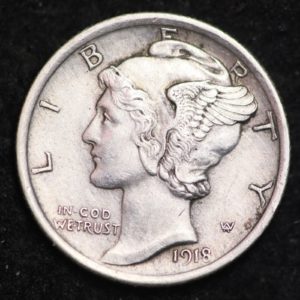Mercury Dime
Despite being in its name, the Mercury dime does not feature the god Mercury at all. The portrait on the obverse is that of Liberty wearing a Phyrgian cap. But the term Mercury was used to describe the coin early on and the name stuck.
The Mercury coin was first minted in 1916 and continued until 1945 when it was replaced by a design featuring a portrait of the recently deceased Franklin Roosevelt. In 2016, the dime was re-struck in gold to commemorate its centenary.
History of the Mercury Dime
The United States Congress passed an act on September 26, 1890 that allowed the Director of the Mint to “cause new designs” for coins. Carrying out the process needed approval by the Secretary of the Treasury and that coin designs can’t be replaced “oftener than once in twenty-five years.” Mistaking this to mean “must replace,” the Mint Director at the time, Robert W. Wooley, had the design changed once the Barber coins hit 25 years in production.
The Barber coins had been in circulation since 1892 and when the quarter-century mark was reached in 1916, a replacement was already in place. Groundwork was laid late in 1915. The Mint Director invited Hermon A MacNeil, Albin Polasek, and Adolph A. Weinman, three noted sculptors, to come up with designs for new coins, including the dime. Weinman ended up with winning designs for the dime and half dollar.
Weinman’s Mercury dime is consistently hailed as one of the best US coins ever produced. It is said that he based the portrait on the coin on a bust he did in 1913 of Elsie Kachel Stevens, the wife of poet Wallace Stevens. The portrait is featured on the obverse side of the coin.
Also known as the Winged head Liberty dime, the reverse features fasces, which was a symbol of authority in ancient times, and a battle ax on top to represent preparedness. An olive branch is also featured beside it to indicate desire for peace.
In 1916, World War I was raging in Europe. A year later, the US would take part in the war. The coin remained in the lineup of US coins right through the end of World War II. As such, it was in use throughout major events in US history, including the Great Depression.
Although it gave way for a dime featuring Franklin Delano Roosevelt in 1945, it remained in circulation until the 1960s.
Collecting Mercury Dimes
The 1916 Mercury dime struck at the Denver Mint is the key date of the series, with more than 200,000 pieces produced. The output was rather low as large orders were made for quarters. The mint began striking again in 1917, making coins from that production rarities.
There are just a few varieties in the Mercury dime series. The 1942/41 Mercury dime, called an overdate, features a double die error where the obverse took an impression from a hub dated 1942 and another from 1941. The 1945 dime is quite popular for the Mint’s use of a puncheon.
A centennial version was released by the Mint in 2016.
